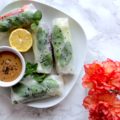
When it comes to cooking, my grandma is simply the best! I know what you must be thinking now: well everyone says that about their granny. But even grandchildren from other grandmas say this about my granny. One of the reasons her food is so delicious: her Persian roots. Ever since I can remember, I link delicious food to visiting her. Also: You can’t just stop eating when you’re full. “Come on, eat some more, my dear!” (that’s so Persian) “At least some fish” (btw she still tells me that even though I told her I wouldn’t eat any meat or animal products in general). She taught me a lot about nutrition at a young age. I haven’t even reached puberty when I already knew that pomegranate would help with menopause complaints. Generally Persians know a lot about the food they eat and their effect on our bodies. A lot of English words for food originate in the Persian language, such as orange, pistachio,spinach. This fact by itself says much of the heritage and influence of the persian cuisine.
Persian cuisine
Persian cuisine is considered the mother of all oriental cuisines. As rice is a staple food here, you can find it on every table as a centerpiece. I would even say that Persian rice is the best there is. It’s very different from the sticky East Asian rice (which undoubtedly has its own preferences in certain dishes). What makes it so special is the delicious golden crust, called Tahdig in Farsi. Nowadays, a lot of Persian households use an electric rice cooker that makes the crust automatically. However, you can make tahdig in a regular pot, too – it just requires a little more effort. But it’s absolutely worth it and it always works out with these proven and tested instructions!

Persian Jeweled Rice with Golden Crust (Tahdig)
[ingredients title=”Ingredients”]
- 2 cups Basmati rice (500 g)*
- 2 tbsp and ½ tsp salt, divided
- 4 tbsp frying oil (or coconut oil)
- 2 tsp whole cumin seeds
- 2-3 small potatoes, sliced
- 3 tbsp barberries**
- 3 tbsp pistachios, chopped (preferably roasted and unsalted)
- 2 tbsp slivered almonds (or chopped)
- 1 tsp saffron
- ½ tsp sugar (I use coconut sugar)
[/ingredients]

[directions title=”Directions”]
- In a colander wash the rice thoroughly until the rinsed water runs clear. (For best results, soak rice in cold water and salt for 1 hour.)
- In a large pot, bring water and 2 tablespoons of salt to a boil on medium heat. Add the rice to the boiling water. Bring back to a boil and cook al dente in about 7 minutes. Drain in a colander and rinse under warm water.
- In a large pot (if using the same pot, make sure to dry it first) melt oil on medium heat and add cumin. Cover the bottom with potato slices (mosaic-like) so that no big gaps remain in between. Sprinkle some salt over potatoes and sauté for 1-2 minutes.
- Add enough rice to fully cover the potatoes. Using the back of a wooden spoon, press down the rice gently. Add the rest of the rice in the shape of a pyramid.
- With the handle of a wooden spoon, poke a couple of holes into the rice, not all the way down to the potatoes though. Drizzle 2-3 tablespoons water over the rice.
- Cover the lid with a clean kitchen towel and place it firmly on the pot. Turn the heat down to low and steam for 40 minutes without lifting the lid.
- Meanwhile soak barberries in water for about 30 minutes. Drain and pat them dry with a kitchen towel. Leave barberries that way or sauté in 1 tablespoon oil.
- In a mortar pestle saffron together with sugar and mix together with 2 tablespoons of water.
- As soon as the rice is cooked, mix a few tablespoons of it with the saffron water.
- Arrange the remaining rice (except for the crust) on a large serving plate. Fold in barberries, pistachios and almonds.
- You could either flip the whole Thadig onto a plate, or using a spatula, break down into pieces and remove out of the pot separately.
- Serve immediately together with the remaining rice and the yogurt dip (Mast O Khiar).
[/directions]
The rice will keep in the fridge for up to 3 days. The Tahdig should be eaten right away, though. But honestly I have never seen any Tahdig left over.
Mast O Khiar (Cucumber & Mint Yogurt)

[ingredients title=”Ingredients”]
- 2 cups yogurt (I use soy yogurt) (500 g)
- ½ cucumber, grated coarsely or cut into thin stripes
- 1 handful of mint
- Salt & pepper, to taste
- Optional: Pomegranate for garnishing
[/ingredients]

[directions title=”Directions”]
- Simply mix all the ingredients together in a bowl. Enjoy with a rice dish or as a dip.
[/directions]
Store in an airtight container in the fridge up to two days.
Notes:
* If you can’t get hold of Persian rice – white Basmati rice is very similar.
** You can find barberries in Persian/ oriental stores or online, of course.






1 Kommentar
can’t wait to try